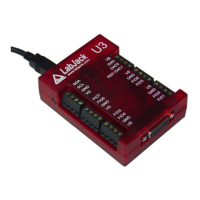4.3.8 Raw Output/Input
The a
fun
to acce
LJ_ioR
LJ_ioR
When u ecifies the desired communication pipe. For the U3, 0
is t n
in value
the val
Followi
(Sectio
wri A
numByt
numByt
//Raw Out. This command writes the bytes to the device.
Get(ln RAW_OUT, 0, &numBytesToWrite, pwriteArray);
_IN, 0, &numBytesToRead, preadArray);
the very flexible IOType based method normally
ed by this driver. There are 6 functions available:
eAIN()
eDAC() te to 1 analog output.
I()
O() tput.
CConfig() //Configure all timers and counters.
In addi automatically handle configuration as
needed ets the specified line to digital output if previously configured as
analog and/or input, and eAIN() sets the line to analog if previously configured as digital.
The firs eads. These
function Go/Get
method with IOTypes, many operations can be combined into a single low-level call. With
ction or Add/Go/Get.
he last two functions handle almost all functionality related to timers and counters, and will
any other method. These easy functions are recommended for most
s.
re re two IOTypes used to write or read raw data. These can be used to make low-level
ction calls (Section 5) through the UD driver. The only time these generally might be used is
ss some low-level device functionality not available in the UD driver.
AW_OUT
AW_IN
sing these IOTypes, channel # sp
he ormal pipe while 1 is the streaming pipe. The number of bytes to write/read is specified
(1-16384), and x1 is a pointer to a byte array for the data. When retrieving the result,
ue returned is the number of bytes actually read/written.
ng is example pseudocode to write and read the low-level command ConfigTimerClock
n 5.2.4).
te rray[2] = {0x05,0xF8,0x02,0x0A,0x00,0x00,0x00,0x00,0x00,0x00};
esToWrite = 10;
esToRead = 10;
gHandle, LJ_io
e
//Raw In. This command reads the bytes from the device.
eGet(lngHandle, LJ_ioRAW
4.3.9 Easy Functions
The easy functions are simple alternatives to
us
//Read 1 analog input.
//Wri
eD //Read 1 digital input.
eD //Write to 1 digital ou
eT
eTCValues() //Update/reset and read all timers and counters.
tion to the basic operations, these functions also
. For example, eDO() s
t 4 functions should not be used when speed is critical with multi-channel r
/
s use one low-level function per operation, whereas using the normal Add
single channel operations, however, there will be little difference between using an easy
fun
T
usually be as efficient as
imer/counter application
t
Following is example pseudocode:
72

